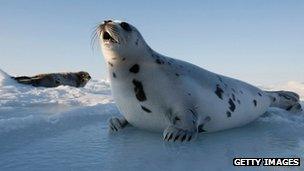Namibia's controversial annual seal hunt set to begin
- Published

Namibia's seal hunt is thought to be the world's second largest, after Canada's
Namibia's annual seal hunt is set to begin on Sunday, amid an outcry from conservation groups.
The target this year is to club 80,000 pups and 6,000 bulls by the time the hunt ends in November.
Namibian authorities say the cull is necessary because of a burgeoning and unsustainable seal population which threatens the fishing industry.
But campaigners say the hunts are carried out for commercial gain, as the seals' fur and fat is sold on.
Namibia's seal hunt is reported to be the world's second largest, after Canada's notorious annual cull of its seal population.
It takes place in two reserves where the seals are rounded up on the beach and hit on the head with spiked wooden clubs.
The carcasses are processed in the factories of seven commercial licence holders, which harvest the seals for their pelts, fat and male sexual organs, which are believed to have aphrodisiac properties in some parts of the world.
Seal product ban
"Namibia's seal population has increased to the point where they exceeded by far the carrying capacity of the environment," the government said in a statement.
"Therefore it is humane to curb the unrestrained seal population to a level where they can be sustained by the environment."
Jason Bell, director for Southern Africa at conservation charity International Fund for Animal Welfare, told the AFP news agency: "There is no justification for the killing. This is purely a political and economic issue, with very little concern for animal welfare."
He said that bans on the imports of seal products by the United States and European Union could help to raise awareness and shrink the market for seal goods.
Last year, a report commissioned by a coalition of environmental groups found that seals were more valuable to Namibia alive.
The study, The economics of seal hunting and seal watching in Namibia, found that revenue gained from tourists travelling to Namibia for seal watching outweighed the revenue from the hunt.
In addition to Namibia and Canada, seal hunting also takes place in Iceland, Norway, Sweden, Finland and Greenland.